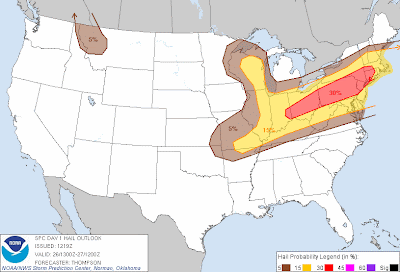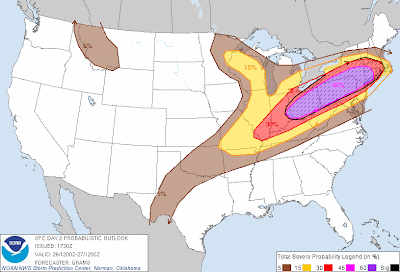I was recently given a complementary copy of the book "Joplin: The Miracle of the Human Spirit" and asked to review it. It was my pleasure to read it, and I highly recommend the book to anyone with a specific interest in the Joplin tornado disaster, as well as weather related disasters (and managing and/or responding to them) in general.
The book was written by Mark Rohr, the City Manager of Joplin, and provides his own personal and professional account of the first 6 months following the disaster in Joplin. An excerpt from the Introduction of the book describes it quite well: "Based on a daily journal Mark kept from the beginning, the book gives the reader a behind the scenes glimpse into the priorities, the meetings, the proposals, the details, the inner workings of an organized plan to bring Joplin back even better than before."
As far as I'm concerned, the book starts off with a bang - and not one that you would expect (at least I wasn't expecting it). From Chapter One, "A Third of Joplin in Ruins", came this revelation by Mr. Rohr (referring to that fateful day, Sunday, May 22nd, 2011): "I had been home on the south end of the city, unaware of any threatening weather..." Around 5:50 pm, Mr. Rohr received a call from the Fire Chief, informing him of the disaster that was literally unfolding at that time.
This revelation was incredibly disturbing to me. I'm not blaming Mr. Rohr personally, but there was no reason that he should have been caught "unaware of any threatening weather" on that day. Forgive me if I take this personally, but as regular blog readers know, it has literally been my business for the last 20+ years to make sure that folks in Mr. Rohr's position (as well as the public at large) are aware of impending severe weather situations so as to avoid tragic loss of life and other unfortunate outcomes. In my opinion, the City of Joplin, including Mr. Rohr, deserved better than to have been taken by surprise by this event. I am, of course, referring to what (again, in my opinion) was an overall poor performance by the National Weather Service on that fateful day.
Commercial Damage on Rangeline Rd. (Photo from the book)
There is one entry in the book where Mr. Rohr became agitated (again, my word, not his), by a statement from a National Weather Service employee following the event (and I believe very rightly so, as you will see below).
I almost fell out of my chair when I read this line, where Mr. Rohr was quoting the words of a member of the National Weather Service team charged with performing the post tornado "damage survey" and assigning the "official" intensity rating of the tornado. The National Weather Service employee told Mr. Rohr (referring to the intensity of the tornado): "I...believe it was an EF4...", and went on to say that "assigning a higher EF5 designation would be a political decision".
WHAT????? Surely I misread that. I reread the account at least three times, and my eyes were not deceiving me - that's what the man said. Assigning a damage intensity rating to a tornado should never involve politics. The pictures, videos and eye witness testimony of the damage will tell you how strong the tornado was, plain and simple.
I have long maintained that Dr. Ted Fujita, the pioneer of the U.S. tornado rating system and the world-reknowned master of performing tornado damage surveys is rolling over in his grave at the poor execution (which may be a charitable assessment) of today's National Weather Service tornado "damage survey" process. This account only went on to confirm that suspicion in a major way.
While it is unclear what "political decisions" may have come into play, ultimately the National Weather Service rated the Joplin tornado the maximum EF5 intensity, which was overwhelmingly supported by all of the photos, videos and other ground damage survey information.
Whew. Okay, I'll get off of my soap box, remove the blood pressure cuff and get back to the book review now...
Damage to St. John's Hospital (Photo from the book)
"Making It Up As We Go" is the title of one the early chapters. Mr. Rohr points out that there was no "instruction manual" available to him or his staff in the aftermath of the disaster. According to Mr. Rohr, like most cities, Joplin's Emergency Operations manual "usually consists of no more than a contacts list". He goes on to say "I'm pretty sure the officials that draft such documents never envisioned a catastrophe of the magnitude we were facing. By sheer necessity, we would have to make up our response as we went."
Indeed, the Joplin tornado was a catastrophe of unprecedented proportions, at least in modern times. One of the stunning facts pointed out in the book was that 3 million cubic yards of debris were removed from Joplin in just over (an astounding) two short months following the tornado. In the 2001 World Trade Center disaster, 2 million cubic yards of debris were removed.
The tornado did some amazing "debris removal" of its own: 29 manhole covers, each averaging 200 pounds in gross weight, were pealed away from the earth and tossed around like toys.
We all know the devastating human toll that the tornado also took on Joplin, with 161 people having lost their lives. A somber appendix lists the names of each of the 161 victims of the tragedy, and throughout the book Mr. Rohr, the city staff and residents pledge to rebuild Joplin better than ever before, as a tribute to those who lost their lives.
The book details another tribute that is underway, in the form of a memorial at Cunningham Park. I had the pleasure of visiting the park just 2 weeks ago, and found myself speechless standing there in that beautiful space while at the same time staring across 26th Street at the broken down shell that was once St. John's Hospital. The contrast was striking, and no picture or video clip can do it justice.
Waterfall at the Memorial (Photo by Rob White)
The old hospital site is being leveled, and a brand new facility is under construction in south Joplin. The process involved with selecting the site for the new hospital is outlined in detail by Mr. Rohr in the book.
From rebuilding the High School, to rebuilding a key retail district, to rebuilding single and multiple family residences, the book gives a detailed accounting of the process (and at times, the politics) involved with getting the job done. As you may recall, over 7,500 homes in Joplin were impacted (of which 3,500 were destroyed or deemed uninhabitable), as well as over 500 businesses.
Numerous impressive facts (did you know that over 113,000 volunteers officially registered to help with the clean-up and recovery effort), are presented throughout the book, as well as in a "summary" near the end.
As a result of working (literally) through this tragedy, Mr. Rohr and his team have developed something that they refer to as "The 10 Tenets of Disaster Management". He shares the 10 tenets and explains them in great detail throughout the book, citing the real life examples of how each were put into practice in Joplin.
As you can probably imagine, Mr. Rohr has become a sought after speaker and adviser on managing a disaster and coordinating a recovery effort, and he honors those requests as his busy schedule allows, always putting the citizens of Joplin first. In fact, that is the basis of tenet #4: "Don't get seduced by the limelight - stay focused on what is important."
Again, I highly recommend this book to a wide variety of readers. Even those with little to no interest in the weather but an interest in disaster preparedness and management will find it a very interesting and informative read.
Entire Neighborhoods Were Destroyed (Photo from the book)
As you can imagine, the recovery and rebuilding of Joplin is an ongoing process that will not be completed in a short period of time. For that reason, I would love to see a follow-up version of the book next year (even if just published electronically) so as to update everyone on the progress that has been made on several of the key fronts that are outlined in the book. We can, of course, obtain some of this information from the media, however Mr. Rohr's perspective from the "front lines" provides a great deal of detail and background which a 1 minute and 30 second news story simply cannot accomplish.
A portion of the proceeds of the book will go to the ongoing recovery efforts in Joplin. If you would like to contribute in other ways as well, several suggestions are offered, including a visit to www.rebuildjoplin.org, which is a reputable a site to which we have referred blog readers since last year.
For more information from the Original Weather Blog, including "live blogging" during rapidly changing weather events, please be sure to follow me on facebook and/or twitter:

































